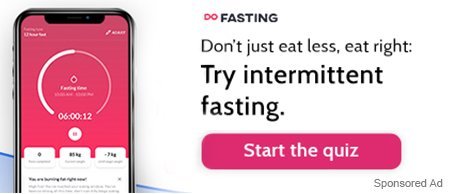What Is Clean Fasting | What is Dirty Fasting | Does Dirty Fasting Work | Dirty Fast Vs. Clean Fast
With more and more people gravitating towards intermittent fasting for its various health benefits, many new terms keep coming up in the world of health and fitness. Two such terms include dirty fast and clean fast.
People who are just starting intermittent fasting might get confused about which one they should adopt and the difference between these two terms.
Before we talk about dirty and clean fasting, let us understand what intermittent fasting is? In simpler words, Intermittent Fasting can be described as strategic starvation or fasting done in cycles where a person restricts all calorie intake for some time and then eats all of their recommended dietary allowance within the eating window.
Now we have understood that Intermittent fasting involves fasting or not eating anything for certain hours in a day. The terms clean fast and dirty fast are related to the foods you consume during your fasting window.
Let us compare clean fast vs. dirty fast and know how these can benefit your body.
What Is Clean Fasting?
Let us start with clean fasting. Clean fasting, as the name suggests, is the type of fast where you follow all of the intermittent fasting protocols and restrict the intake of any calorie throughout the day. So, the food items that you consume have zero to negligible calories. These include water, black coffee, plain tea, and sparkling water.
The main aim here is to activate ketosis, a fat-burning process in the body. Ketosis helps shift the body towards burning fat rather than using energy from food or blood glucose.
Apart from ketosis, fasting also activates a process called autophagy. Autophagy means eating the self. It does not mean that your body will start eating itself, but when your body experiences a long duration of fasting, the cells will begin using the damaged components to produce energy. It is a healthy procedure that can help avoid the risk of cancer, improve mental health, and improve the body’s overall immunity. During a clean fast, autophagy occurs in the body, especially for people who fast for over 16 hours on a stretch.
To know more about autophagy and how fasting affects it, read Autophagy & Fasting: All You Need To Know.
Clean fast can also be a more restrictive approach towards fasting where even artificial sweeteners are not allowed for the practitioner. That is because these sweeteners can raise insulin levels which will not let the body use fat for energy.

What is Dirty Fasting ?
On the other hand, dirty fasting is when you consume foods or beverages under 50 calories during your fasting period.
So, if you add that milk or cream into your coffee, it is considered dirty fasting. Even consuming bone broth is included in dirty fasting. So, during the dirty fasting, a person can consume 1 tbsp cream or milk, 1 tbsp of honey or maple syrup, stevia, aspartame, MCT oil, 1 cup bone broth, sugar-free lemonade, and sugar-free gum during the fasting window. However, it is advised to avoid eating gum during any kind of fasting because it might lead to the feeling of hunger.
When we talk about dirty fasting, it is essential to note that this is not a medical term; it is just a term made-up to refer to the kind of fast we follow. Also, some people might consume more than 50 calories during the dirty fast.
So, there are no set dirty fasting rules except that the calorie intake should not go over 100 kcal. According to people who practice dirty fasting, fewer calories will not essentially break the fast.
So, Does Dirty Fasting Work?
The concept of dirty fasting does not include total restriction of calories; is it still effective? How many calories will kick you out of a fast?
Well, it depends on what you expect from the fast. If you are only focused on weight loss and intermittent fasting to restrict your calorie intake, then dirty fasting will show weight loss.
However, if you aim for ketosis and high-efficiency fat burning, then dirty fasting is not the right choice. Also, intermittent fasting benefits are not limited to weight loss or fat burning. People also use it as a way to lower insulin levels and for autophagy. From improving your insulin resistance to promoting self-healing in your body, intermittent fasting carries a variety of benefits.
Hence we can say dirty fasting is not as effective as clean fasting. But it is also true that dirty fasting does promote fat loss and weight loss, but it will not give you other health benefits.
No matter how small the number of calories that you consume, it is still calories you are putting in your body. So, it breaks your fast.
There is a lot of misinformation on the internet about 50 calories being ok to consume. But again, food is broken down in the body and used in the cells, in the same way, no matter how little you eat.
Finally, we can say, dirty fasting will break your fast and is moderately effective, and comes with its own set of advantages and disadvantages.

Dirty Fast Vs. Clean Fast What Should You Choose?
If you are starting intermittent fasting and want to know which one of the two fast types will be more beneficial for you, here are some points to keep in mind;
Why Are You Fasting?
The first question you should ask yourself is why you want to fast. If you’re going to fast just so that you can restrict your calorie intake during the day and lose weight in the process or create a structured timetable for consuming food, dirty fasting is an option you can consider. Dirty fasting will also aid in weight loss, no matter what.
However, if you also want to see other benefits such as improved blood sugar levels and autophagy, practicing clean fast where you do not consume any energy is the right choice.
How Long Is Your Fasting Window?
If you are fasting for over 16 hours, maintaining a clean fast can be difficult for some people. In this case, you can take some coffee or tea or sparkling water. However, if you can maintain the fasting state for long durations, it is much better to stick to fasting that has been proven to show results, which is clean fasting.
The better type of fasting in the clean fast vs. dirty fast debate depends on each individual. Everyone has their own goals that they want to achieve from intermittent fasting. Hence, if you know the pros and cons of each of these fasts, the choice ultimately depends on your comfort.
If you are a beginner, you should always consult a dietitian before starting to fast because intermittent while might be beneficial for health does not mean it is a one-size-fits-all solution. In some people staying hungry for longer durations can be detrimental to health. If you are a healthy individual, you can try with small durations of fasting and build from there.
Also, it is fine if you want to combine the two kinds of fasting. You can consume some amount of calories on days where you can not stay hungry. Having a small amount of fat or protein can help in dealing with your hunger pangs occasionally. Ultimately you need to pick the type that gives you results.
Final Thoughts
To conclude the debate of dirty fasting vs. clean fasting, it can be objectively seen that a clean fast has much more benefits than a dirty fast.
So, if you can fast for more prolonged durations, then definitely go for clean fasting. For beginners, it is better that you start with smaller fasting windows to increase your tolerance. You can start with a small window of 12 hours and then increase it as you go. The maximum can be 18 hours. Also, if your goal is only weight loss and you are not interested in any other benefits of intermittent fasting, you can choose dirty fasting.
The bottom line is that you will consume some calories with dirty fasting, which means that your body will not remain in the true fasting state, and dirty fasting can technically not be considered fasting. So, if you are interested in fasting, then the 16:8 method backed by studies will give you much more results than dirty fasting.
Want to know more about intermittent fasting and its types? Read A Complete Guide To Intermittent Fasting + Daily Plan & Schedule.
Want to begin your Fasting Journey? Sign up for a 21-day intermittent fasting challenge where you will get a fasting guide, daily tips, and a 21-day meal plan. Click here to sign up.











